News & Events | About PKU News | Contact | Site Search
A special edition of PKU News in commemorating the 113th anniversary of Peking University.
Peking University, May 2, 2011: As British Prime Minister David Cameron was speaking at Beijing Daxue, or Peking University (PKU/Beida), his press handlers were too wary not to err.
And they did. Hours after the speech, the Downing Street website was reporting that their boss spoke to students at the "Beida University." Rather good as it was — timely update, authentic English, with full text of the transcript. Only were they flummoxed — grilled by an Economist article — by the English name(s) of the university.
Wording matters. Along with PKU's ups and downs in its over 100 years’ history, the university's official English name has changed several times.
I. Imperial University of Peking
Jingshi Daxuetang, or the Imperial University of Peking, was established in 1898 with W. A. P. Martin as its first President. An institution focusing on both Chinese and Western learning, the backbone of the faculty at the university consisted of American, European, and Japanese scholars. English served a significant working language.
It is an undisputed fact that the university had an official English name since its establishment, but different arguments on the exact name remained, partly due to the loss of original archives during the "Boxer Rebellion" and hesitation about the word "imperial" after the 20th century republican revolutions. For a recent period “Jingshi Daxuetang” was wrongly translated as "capital college" or “metropolitan university of Peking” — in even official English documents of Peking University.
Since the Imperial University of Peking was China's first modern national university and also served as the highest administration for the country's educational affairs, its English title should be acknowledged by the authorities, probably the royal Qing court (1644-1911) — instead of arbitrary translations.
The clearest evidence, two official seals of the Imperial University of Peking Library, has been archived at the university. Along with its Chinese name, the English “Imperial University of Peking” was engraved on the ellipse-shaped seals.
The naming was probably influenced by “Tokyo Imperial University” – today’s University of Tokyo in Japan, a model state for China's modernization after the First Sino-Japanese War (1894-95). The Peking university would even follow the curriculum adopted by its Tokyo counterparts, according to a New York Times report on September 14, 1898.
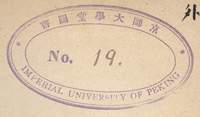
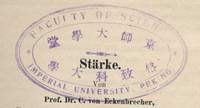
The Imperial University of Peking (File photo via Shen Hong; the same below unless otherwise noted)
Some argued that the English words “Peking University” had been used to address the university only since May 1912 when the Chinese name of the imperial university was changed into “Beijing Daxuexiao” (literally Peking University; but in fact "Government University of Peking"). Nevertheless, a large number of original English sources suggest that the English name “Peking University,” in parallel with the official “Imperial University of Peking,” had both served as the university’s English name since its establishment. Here are examples:
The Shanghai-based English newspaper North-China Herald featured the opening of the university on September 5, 1898:
It is reported from Peking that although the proposed Imperial University has been given temporary quarters in the great temple known as the Ma Wang Miao (Horse Prince Temple) [sic] in Peking, which contains some 280 rooms, these quarters are still too limited in view of the large number of Doctors, Masters of Arts, and Licentiates who have recently applied for the privilege of matriculating in that institution. It is significant that, so far, the number of Hanlin applicants has been very small.
In this report, the name “Imperial University” was used to address the university based in Mashen Miao (Mashen Temple) near today's Shatan Houjie.
Two weeks later, another report on September 19, 1898 by the North-China Herald read:
The Grand Secretary Sun Chia-nai has appointed a Committee of four Metropolitan officers to visit Japan and examine the schools and universities in that country, in order to get information how to manage the proposed Peking University and lower grade colleges. The following are the officers appointed: — The Censor Li Sheng-tu, the Hanlin Compiler Li Chia-chu, the Hanlin Bachelor and Imperial Clansman Shou Fu, and Yang Shih-hsi, second-class Secretary of the Board of Works. They are expected to arrive at this port shortly en route for Tokio.
It is clear that the name “Peking University” was used. More reports covering the Imperial University of Peking by the North-China Herald thereafter could justify the argument. On October 17, 1898, several days after the failure of the Hundred Days’ Reform, the North-China Herald reported:
A Peking dispatch states that with the exception of the Peking University, which is still having precarious existence, all other schools proposed to be established, prior to the coup d’état, have been laid on the table, and the organizers have adjourned sine die. It is also reported that a large number of petty yamens in the provinces which were to be abolished in obedience to the Emperor’s decree in August last, are very likely to be restored by the Empress Dowager who is doing all she can to restore the old status quo.
The English name “Peking University” appeared increasingly frequently in news and reports, not only in texts but also quoted as subtitles. Here is another piece of news by the North-China Herald on April 17, 1899:
Peking University
Rumours reach us here that it is in a more or less parlous state, and its future is far from assured. Its continuation was a sort of sop to Cerberus on the part of the Hsi-Tai-hou — Empress Dowager — at the time of the Palace Revolution. The Reactionist party did not want it now, so that both political and financial difficulties block the way. It is to be noted, however, that the officials of the new Institution seem exempt from the general diffidence about the future.
However, the term “Peking University” was not officially recognized until the 1950s, despite its long history and wide popularity among the public.
II. Government University of Peking
From 1912 to 1919, the received English name of Peking University was “Government University of Peking” (Peking Government University), following the Xinhai Revolution that overthrows China's 2,000-year imperial rule.
The term "government university" is synonymous with today's "public university."
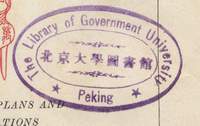
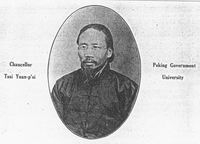
III. National University of Peking
Just months after the imperial university dropped its "imperialism" in 1912, variations of the official Chinese title "Beijing Daxuexiao" emerged in formal documents — "Beijing Daxue," "Bei-Da," and "Guoli Beijing Daxue."
The “Guoli” (national) one prevailed from the mid-1910s, and the previous English rendering "government university" was superseded by "The National University of Peking,” "National Peking University,” or “Peking National University.”
The first choice was officially recognized on August 12, 1919 , as was recorded by Beijing Daxue Jishi (1898-1997) (Peking University Chronicle).
The change was reflected in English news and articles as well. The Peking Leader Special Anniversary Supplement published on February 2, 1919, with several articles from the university’s professors and pictures of the then President Cai Yuanpei, put the university’s name as “Peking Government University” in English. However, the same newspaper published on February 16, 1920 styled the university as “Peking National University.”
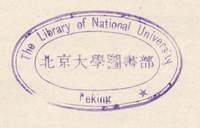
In the 1930-40s, due to the fact that Peking was renamed “Peiping" (Beiping) in 1928, “National Peking University, Peiping” then appeared on materials about the university.
IV. National Southwest Associated University (first as Changsha-based provisional university)
After the War of Resistance against Japanese Aggression broke out in 1937, Peking University, together with Tsinghua and Nankai universities, moved to Changsha, Hunan and then jointly formed “Guoli Changsha Linshi Daxue,” or the National Provisional University of Changsha. Due to the deterioration of wartime situation, the provisional university was compelled to move even southward to Kunming, Yunnan, with its name changed as “Guoli Xinan Lianhe Daxue,” or the National Southwest Associated University (1938-46).
"Guoli Beijing Daxue" (National Peking University) was resumed in Beiping after China's victory in World War II.
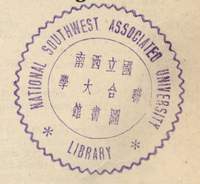
V. Peking University
It is after the establishment of the People’s Republic of China that Peking University officially adopted its current English name.
During the 1952 nationwide restructuring of departments and colleges, Yenching University (Yanjing Daxue), a Christian college just turned state-run in 1951, was merged into this university.
All education institutions on the Chinese mainland were "nationalized" after the restructuring; The former marker "national" was dropped from their names.
Since then, the university has been officially named “Beijing Daxue"/"Peking University.”
The English term was not monopolized, however. It used to refer to "Jingshi Tongwenguan," or the Tungwen College of Peking, the first official institution for Western studies founded by the Qing court in 1862. The proto-university in the capital was merged into Jingshi Daxuetang in 1902.
“Huiwen Daxue” (Huiwen University), or the Methodist University of Peking (founded by the Methodist Episcopal Church in the 1880s in the Chinese capital; one of the precursors of Yenching University), called itself “Peking University,” which was inherited by Yenching before the latter launched its own official English title in the 1920s. Therefore, PKU’s move into the former Yenching campus and “inheritance” of the historic name were a space time crisscross.
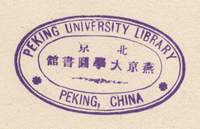
In the 1970-80s, the new Peking University temporarily changed its English name into “Beijing University,” coinciding with the recommendation that the pinyin system be adopted as the international system for the romanization of Chinese geographical names by the 1977 Third United Nations Conference on the Standardization of Geographical Names, the State Council's approval of the proposal on using pinyin as the standard system for the romanization of Chinese person names and geographical names in 1978, and the International Organization for Standardization's adoption of pinyin as the international standard in 1982. However, the words did cause confusion with other universities in Beijing such as “Beijing University of Posts and Telecommunications.”
The university gave up such change shortly afterwards, as the office meeting of presidents (Xiaozhang bangong huiyi) on December 19, 1980 decided that the English appellation be resumed as "Peking University," according to Beijing Daxue Jishi (1898-1997).
“Peking” has been thus regarded as an indivisible part of the 100-year proper noun “Peking University,” rather than the outdated postal spelling of the geographical location “Beijing.” Today, the English words “Peking University” have gone deep into the heart of people home and abroad and become a unique symbol of China’s top institution for higher learning, of her prestige, and of her history.
With the popular acronym “PKU” since the late 1990s, Peking University is more widely recognized in international communications as "Beida" ("Peita" before the pinyin spelling was applied) — the transliteration of its Chinese nickname.
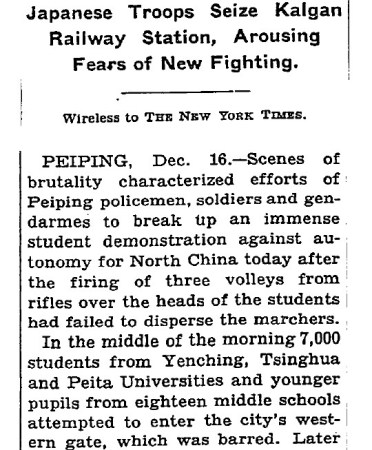
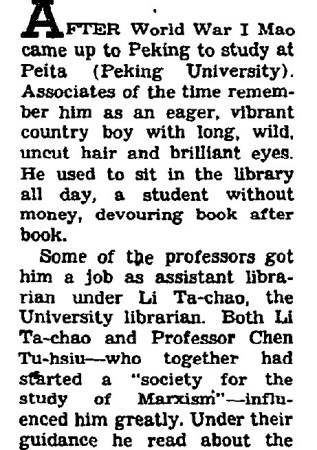
20th-century reports on Peking University with its truncated English name
L: "Peiping students beaten by police." The New York Times 17 Dec. 1935
R: "The man who would be China's Lenin." The New York Times Magazine 19 Dec. 1948
That appeals to the Number 10 Downing Street, at least; the Economist writer knew more.
However, readers in turn grilled the article's author: he mistook "Peking" for a Wade-Giles transliteration, as the historic word actually pre-dates the system.
To the original article the Economist writer immediately attached a correction and apology.
Reference:
Shen Hong. "Zunzhong lishi, jujue yanpin — Huigu Beijing Daxue lishi shang ceng caiyong guo de Yingyu xiaoming" (Respect history and refuse counterfeiting: a review of Peking University's English names in history). 21 Shiji: Renwen yu shehui — Shoujie "Beida Luntan" lunwenji (21st century: People and society — A collection of thesis of the First PKU Forum). Beijing: Peking University Press, 2002.
Extended Reading:
【Anniversary Special】PKU Anniversary Day: Questions and the answer
【Anniversary Special】Anthems across a century
【Anniversary Special】W. A. P. Martin: Inaugural president of the Imperial University of Peking
【Anniversary Special】How to "identify" PKU
【Anniversary Special】Cai Yuanpei interprets the PKU Banner
Written by: Jacques and Gong Ting
Edited by: Jacques
Tag: Anniversary 2013